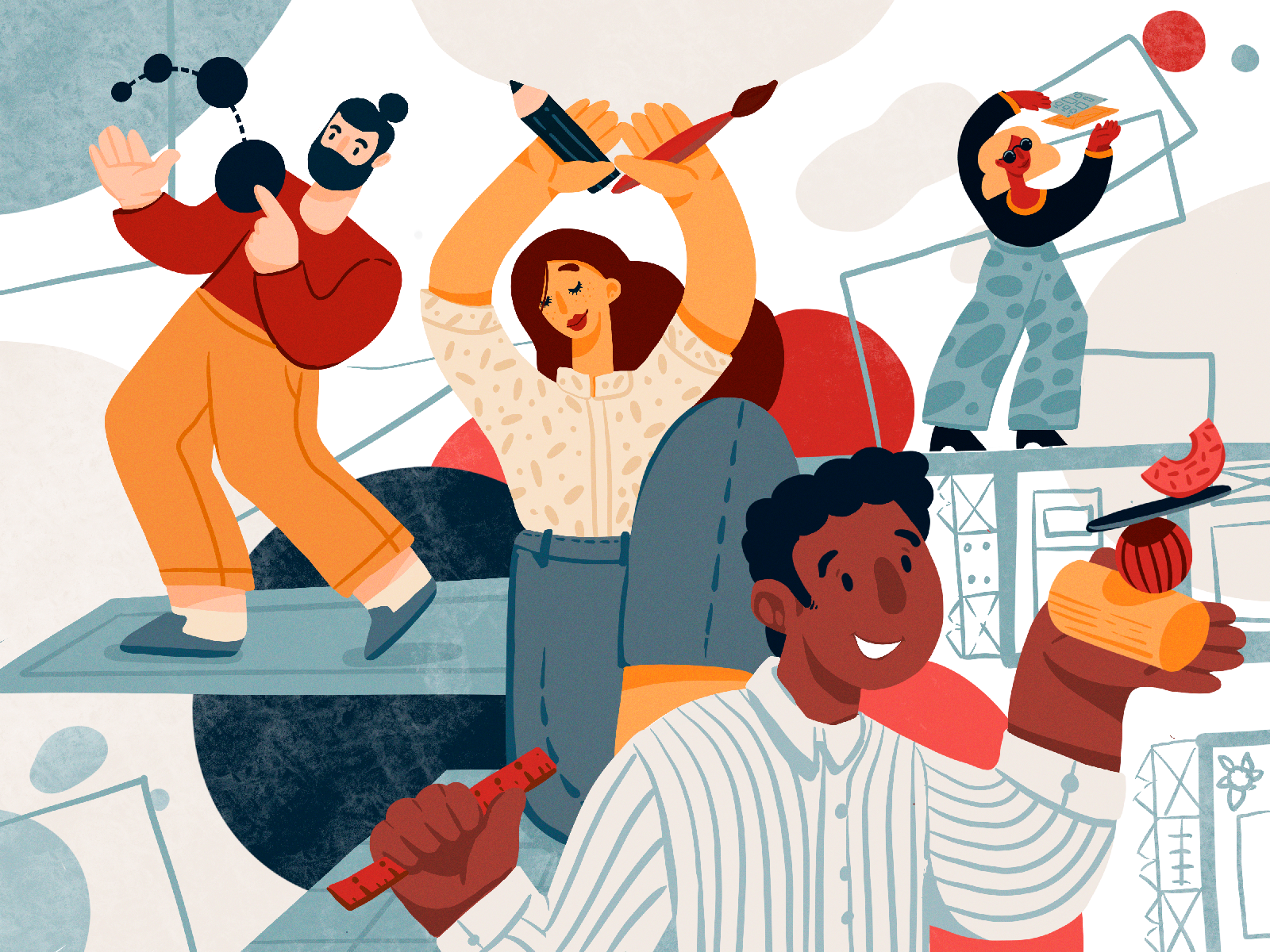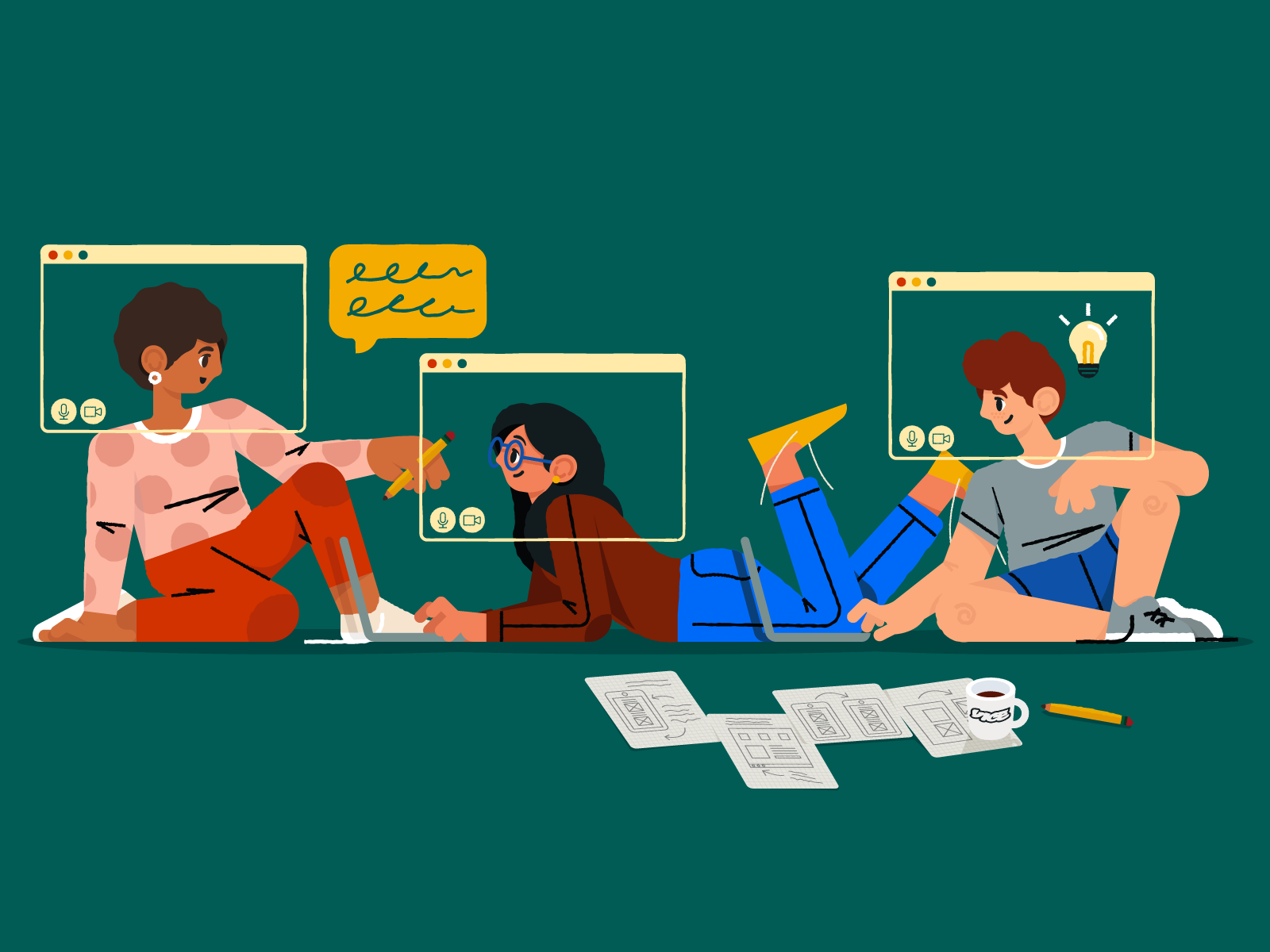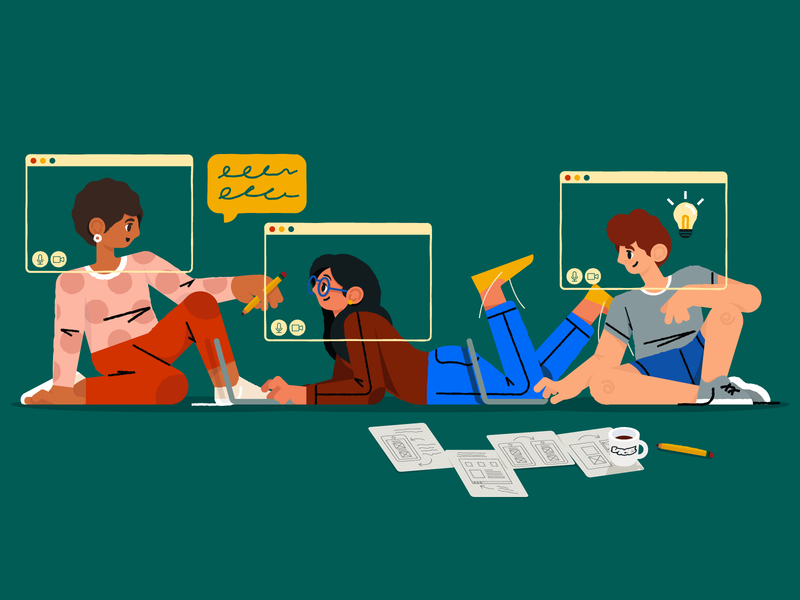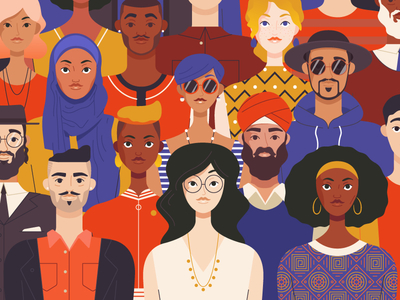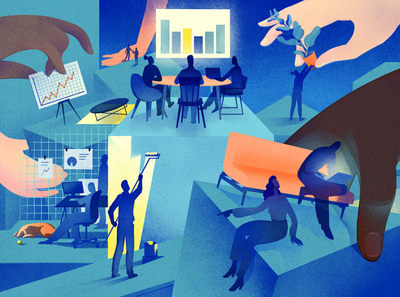In this guest post by Shayna Hodkin , we talk to eleven senior designers & recruiters who all agree we need junior designers now more than ever. Keep reading to learn why. ■
Junior designers are the key to building successful design teams in 2021.
If you believe that design makes everything possible—and I certainly do—then you should believe that design can save us from the effects of 2020.
New problems demand new solutions—something design can provide if we’re willing to take a few leaps. We have to start by rebuilding our design processes: to prioritize innovation over industry norms, and to bring in new talent who can help us redesign design.
We spoke to 11 senior designers and design recruiters who think junior designers are the key to developing perspectives and solutions for a world we never could have imagined.
Let’s discuss the top seven reasons they think you should be hiring junior designers:
- 1. Solve new problems with new talent
- 2. Support your senior designers
- 3. Introduce new design practices
- 4. Build a diverse team
- 5. Increase retention, engagement, and loyalty
- 6. Address underlying culture issues
- 7. Cut costs
1. Solve new problems with new talent
Have you ever lived through a pandemic before? I haven’t. Even my grandma hasn’t.
The problems we’re dealing with (and designing for) are unprecedented. The design methods we’ve been using became outdated over the course of a single month. The world has changed, and our design techniques need to catch up.
Pablo Stanley, founder of Blush Design and former senior designer at InVision and Lyft, agrees that now is the time to shake up our pipelines. Stanley says we need to invest in incorporating new minds into our teams in order to solve new challenges.
This belief is echoed by senior UX manager at Google, Aastha Gaur . She believes that the “new normals” we’re building are so far away from the world we used to live in that being new to the field is a competitive advantage.
Gaur told us that, “Almost everything that used to be ‘normal’ is now gone. It is a competitive advantage in this scenario to not be bogged down by historical context that is completely irrelevant…and the easiest way to bring in fresh ideas is, you guessed it, bringing in fresh minds.”
Taking the time to redesign our design practices may feel impossible in these turbulent times, but Emily Campbell , co-founder and VP product at BookClub and former director of experience strategy at InVision, argues that now is the time to slow down and work thoughtfully.
Though it may take more time and energy to onboard juniors than seniors, Campbell argues that equating good design and fast design will get you stuck in the “build trap,” focused on how much you’re shipping right now instead of long-term success.
2. Support your senior designers
Many of us are struggling with higher stress levels, both at work and in our personal lives. Who would turn down some help? We’re in all-hands-on-deck mode and need to fill our teams with designers who are willing to get their hands dirty.
For senior designers who haven’t spent much time pushing pixels over the last few years, that’s not going to be an easy switch; however, junior designers are often more than willing to get down into the nitty-gritty and offer enthusiastic support.
To explain the unique value that junior designers bring to the market, UX designer Kriti Bajaj , put together a flowchart highlighting the integral differences between junior and senior designers (pictured below).
She argues for a systems-level approach to recruiting and hiring juniors: that investing in robust onboarding programs and conducting training sprints will pay off with new hires who can take over much of the day-to-day routine production work, giving senior designers more availability to take on bigger challenges.
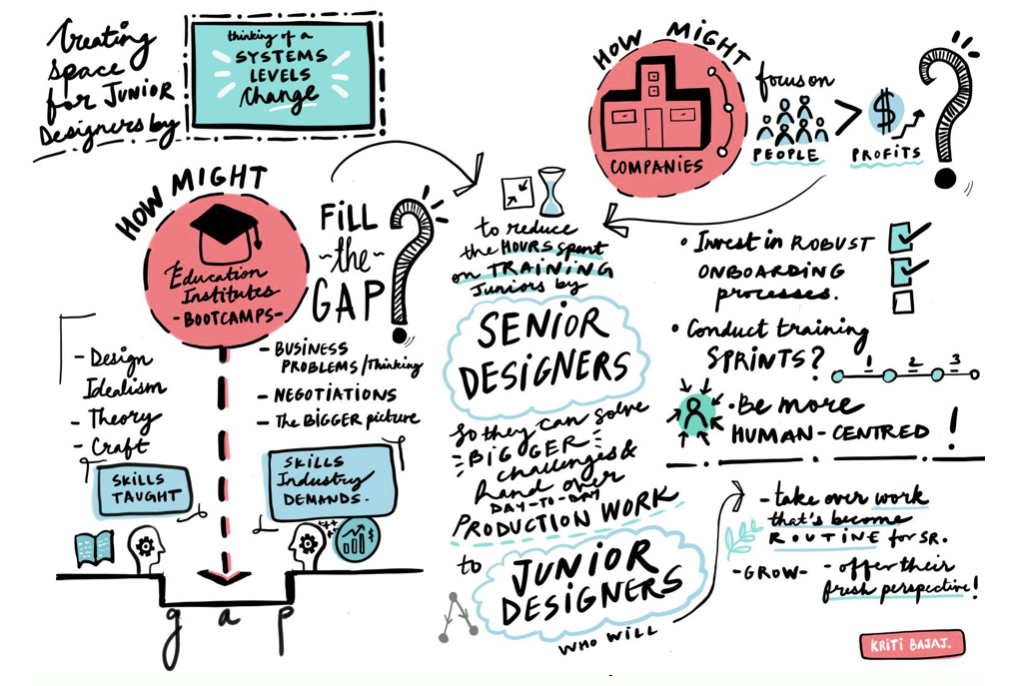
Mindmap of system-level changes needed to make space for junior designers by Kriti Bajaj.
Many of the senior designers and recruiters we spoke to agreed with Bajaj’s sentiment. UX Portfolio Formula founder, UX researcher, and experience designer Sarah Doody told us she recommends companies hire junior designers in order to free up more experienced senior designers to do more strategic work.
Sarah says, “Designers who have been at your company for a while have internal and business knowledge that junior designers won’t have yet. Adding junior designers to your team can help create space for your other team members to do the high-level strategy work to execute those features, allowing you to empower each team member to excel in their role.”
Taking advantage of your designers’ strengths will help your organization produce better work faster. That’s why Felix Lee , founder of Amazing Design People List , is so committed to helping companies recruit and hire junior designers. Lee agrees with Doody that junior designers can support overworked senior designers, saying that junior designers “help lift the design load off the seniors and bring new trends and insights on the table based on what they’ve seen in the market.”
3. Introduce new design practices
Senior designers, especially those who have been at your organization for a long time, can get stuck in their old ways. A number of the designers we spoke to agreed that a benefit of hiring juniors is their familiarity with new tools, trends, and practices.
InVision’s senior design partnerships manager, Jennifer Aldrich , said that junior designers’ knowledge of “the latest tools and trends creates more innovative solutions.” With fresh eyes, juniors are able to examine problems, or even routine practices, from a critical perspective.
In addition to the hottest design trends, many junior designers bring knowledge of other fields and practices with them. According to InVision’s 2019 Product Design Hiring Report , over 53% of product designers reported having engineering experience, 40% had experience in business operations, and 39% in marketing and advertising, with only 2% reported having no additional experience.
Taking advantage of those complementary skills will help your team gain new insight into other fields’ best practices—and how those can impact their existing processes.
In a blog post in favor of hiring junior designers , Funsize co-founder Anthony Armendariz explains the benefits of hiring career-switchers. “Just because someone is a junior designer,” he argues, “doesn’t mean they’re not resourceful…they bring diverse perspectives and new ways to approach problems.”
For teams struggling to adapt to new workplace norms, hiring junior designers can alleviate some of those pains. Having never worked with the systems you had in place—or in your offices—junior designers can inject new energies and skills where you need them.
Let’s say your company is moving towards more digital-forward practices but your staff designers are having trouble adjusting. Jessica Green , senior manager of design and content at Field Nation, sees this as the perfect opportunity to introduce a junior designer.
For organizations changing their communication practices, Green recommends taking this time to leverage new talent, especially junior designers, who have fresh eyes, an appetite to do more with less, and are ready to ride the wave of rebuilding. Her advice is to “grab a junior, feed and water their drive, and watch them shine.”
4. Build a diverse team
It’s well known that diverse teams perform better than homogeneous ones . But diversity extends beyond race and gender: age and seniority are factors as well.
According to a six-year study of intergenerational teams published by the NIH, age diversity contributes to a number of positive cultural outcomes, including:
- Decreased burnout
- Reduced team conflicts
- Increased performance & positive decision-making, especially on teams with more women
We’re still seeing designers who identify with underrepresented minority groups exiting the design industry due to lack of support or representation. Campbell says, “the only way to build a more inclusive industry is to build a more inclusive pipeline,” a move that will positively impact our entire design practice.
Diversity is positively correlated with innovation, something the design industry desperately needs in these changing times. In a report on workplace diversity published by Gartner, “cognitive diversity” is noted as an important factor in determining team success.
According to the report, “CIOs need to also look for “cognitive” diversity, which is mixing people together with different thinking styles, habits and perspectives…having diversity of thought can be what saves a team from groupthink and allows it to achieve better outcomes.”
Diverse groups of designers can identify with diverse groups of users, as well as stakeholders. For UX designers, gaining insight into diverse use cases can help prevent costly mistakes—like Band-Aids that only match certain skin tones , or guitars that women can’t play without a chiropractor’s support.
Automattic put together a checklist for practicing inclusive design and one of their first suggestions is to diversify your team. “Homogeneous teams,” they wrote, “create narrow designs; teams with diverse experiences create more inclusive designs.” To create inclusive experiences, they write, “Be sure that members of your team don’t come from the same culture, age group, gender, or gender expression, and don’t all have similar experiences and educations.”
5. Increase retention, engagement, and loyalty
To set your design team up for long-term success, hire smart. While senior designers have knowledge and experience, they’re also a flight risk—according to the Bureau of Labor Statistics , designers stay with employers for an average of 3.8 years, the least of all professions they categorize as “management, professional, and related occupations.”
There will always be jobs for senior designers; in a recession there will be fewer, but those roles will still exist. However, even in the best of times, the job search is rarely kind to juniors. Entry-level jobs often demand 1-3 years of experience, with criteria increasing as job markets become more saturated and competitive. These requirements lock-out first-time design job-seekers who are hungry to learn and contribute.
The companies willing to take a chance on junior designers will see their investment paid back handsomely in loyalty, engagement, retention, and productivity.
Designer, podcaster, and digital creative Maurice Cherry sees hiring juniors as an opportunity to influence the future of design leadership. “Many junior designers have the drive to really make an impact at companies,” Cherry noted, “and [by hiring them] companies have a chance to cultivate and mentor loyal and valuable team members.”
This sentiment was supported by Stuart Lo , co-founder and design recruiter at Pixelated People , who sees hiring juniors as pressing play on a cycle of mentorship and empowerment:
“Junior UXers are knowledge sponges and are hungry to learn,” Lo says, “so why not nurture and mold them in return for loyalty and ROI later down the line? … [They] are a robust pool of talent who will become seniors, who will, in time, repeat the cycle of nurturing and developing.”
Green too spoke to the forward-thinking economics of hiring juniors, saying, “Given the budget constraints many companies are facing and any subsequent contraction in headcount, it’s a great time to leverage new talent, especially junior designers, who have fresh eyes, an appetite to do more with less in their budgets, and ride the wave of rebuilding. It’s a fantastic opportunity for them to take more ownership of projects, and grow their skills in a way that may support new directions a company is taking or a re-distributed emphasis of skills/disciplines.”
Want to turn $10 into $1,000? Invest in junior talent.
6. Address underlying culture issues
A common question among the recruiters and senior designers we spoke to was: why not hire junior designers?
For companies wary of hiring and training juniors, the problem might be with their culture—not with junior designers themselves.
Deliveroo design recruiter Mark Hothi shared how he would address recruiting junior designers with a design director, CDO, or hiring manager before kicking off the recruitment process.
“My first question to them would be: “Are we confident a junior designer could be successful here?”
- [Is our company] an environment (people, design and workflow processes and tools, culture) where junior talent can grow and do well? Do we have coaching, performance reviews, and touchpoints where juniors’ strengths and growth areas can be managed properly?
- [Do we have] a career progression framework and org structure where we can plan for juniors to develop into mid-levels and seniors as a long-term goal and measure of success?
- Are we OK with juniors failing as long as it’s fast and forwards, and can we support them throughout?
If everyone is confident with the above then I’ll advocate for investing in junior talent to form part of a long-term talent strategy. If the answers to the above are “no” or “not sure,” however, it’s a risk all around: to the junior designers, to the business, to the people working around them.
Any business should be set up to answer “yes” to those questions. Because if you can’t adapt your business, hiring processes, workflows, and culture up to support juniors, you’re probably making a ton of similar mistakes with experienced staff. It’s just hidden better.”
Hothi’s hypothesis, that culture problems may be at the root of recruitment concerns, was echoed by Campbell, who suggested that hiring junior designers may be the solution to common cultural problems. Hiring junior designers, she says, “forces you to be intentional about your practices and culture…it may make you feel like you need to slow down, but that can be an incredible forcing function.”
When you’re embedded in a culture, you can’t judge it objectively. Introducing new teammates with the freshest of eyes will help you acknowledge and fix problems that might have gone unseen.
Arguing in favor of junior designers’ ability to critically approach culture from the outside, Doody says, “As people spend more time at an organization, they naturally begin to conform to your organizational norms without asking why. Junior designers may be able to spot problems that other people on your team are blind to, bringing a fresh perspective or even just innocently questioning why.”
7. Cut costs
The most obvious reason to hire juniors in a recession: they get paid less.
For organizations trying to save money, hiring may seem like a distant concern. Investing in juniors, however, is a way to hire and grow great talent for—well, not to sound cheap, but cheap.
The designers and recruiters we spoke with unanimously agreed that, in this economy, now is the time to hire juniors. Whether we’re politely talking about “budget constraints” or speaking candidly about salaries, we all know it’s true: junior designers get paid less than seniors. Building a team of juniors is more cost-effective in the short term—and, if you do it right, in the long-term too.
Juniors can fill holes in existing teams, inspiring creativity while doing “grunt work” with a smile. Lo shared with us his feelings about the importance of mixed-experience teams:
“Junior UXers are lower-paid, but no less hardworking and could be more au fait with the latest tools, trends, and ways of working,” Lo said. “Juniors can be added to a team of mids/seniors to induce more creativity and holistic knowledge transference.”
Junior designers are the future
It’s up to us to build the next class of design leaders. The design community should band together now to support our juniors: to invest in them and help them grow, so we can build the future of design together.
Hiring junior designers isn’t just about finding cheap talent or giving an up-and-coming talent a chance—it’s a strategic way to reinvigorate your organizational culture.
We’re in the wild west now, and the old ways of design aren’t cutting it anymore. Junior designers have the perspective, drive, and knowledge that will help us learn how to design for a better world. ■
About the Author: Shayna Hodkin is a writer, editor, and accessibility advocate. You can find her at cookingandhoroscopes@gmail.com. Talk to her about veganism, tarot, and writing projects.
RELATED READING
- Design Hiring: How to thoughtfully onboard a new designer
- How to hire for creative leadership
- Standardizing your team’s criteria for evaluating design candidates
Find more Community stories on our blog Courtside. Have a suggestion? Contact stories@dribbble.com.
